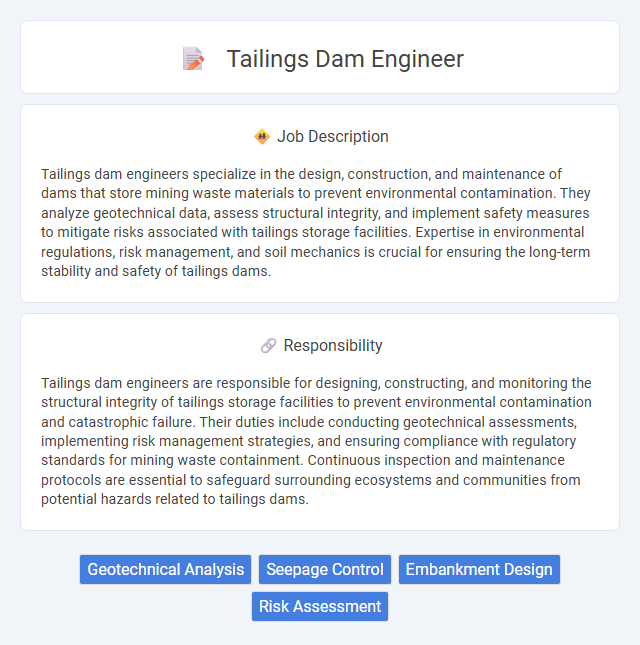
Tailings dam engineers specialize in the design, construction, and maintenance of dams that store mining waste materials to prevent environmental contamination. They analyze geotechnical data, assess structural integrity, and implement safety measures to mitigate risks associated with tailings storage facilities. Expertise in environmental regulations, risk management, and soil mechanics is crucial for ensuring the long-term stability and safety of tailings dams.
Individuals with strong analytical skills, attention to detail, and a background in geotechnical or civil engineering will likely be well-suited for a tailings dam engineer role. Those comfortable working in challenging, high-responsibility environments that require rigorous safety assessments and environmental monitoring may find this career a good fit. Candidates who thrive under pressure and value teamwork could have a higher probability of success in this specialized engineering field.
Qualification
A Tailings Dam Engineer must possess a degree in Civil, Geological, or Mining Engineering, supported by specialized training in tailings management and geotechnical engineering. Proficiency in soil mechanics, risk assessment, and stability analysis is crucial, alongside experience with regulatory compliance and environmental impact mitigation. Certifications in dam safety engineering and familiarity with industry standards such as the International Commission on Large Dams (ICOLD) guidelines significantly enhance qualifications.
Responsibility
Tailings dam engineers are responsible for designing, constructing, and monitoring the structural integrity of tailings storage facilities to prevent environmental contamination and catastrophic failure. Their duties include conducting geotechnical assessments, implementing risk management strategies, and ensuring compliance with regulatory standards for mining waste containment. Continuous inspection and maintenance protocols are essential to safeguard surrounding ecosystems and communities from potential hazards related to tailings dams.
Benefit
Tailings dam engineers likely benefit from specialized expertise in geotechnical and environmental engineering, enhancing their career prospects within the mining and construction industries. They probably enjoy strong job demand due to increasing regulations on mining waste management, which may lead to higher job security and competitive salaries. Opportunities for professional growth and involvement in sustainability initiatives could further contribute to the appeal of this specialized engineering role.
Challenge
Tailings dam engineers likely face significant challenges related to ensuring structural stability and environmental safety under varying operational and climatic conditions. They probably need to address complex risk management issues, including monitoring potential failures and implementing mitigation strategies. The role may demand continuous adaptation to evolving regulations and advancements in geotechnical technologies.
Career Advancement
Tailings dam engineers specialize in the design, construction, and maintenance of dams used to store mining waste, ensuring environmental safety and regulatory compliance. Career advancement in this field often involves gaining expertise in geotechnical engineering, risk assessment, and project management to qualify for senior engineering or consultancy roles. Professionals can also progress by obtaining certifications such as Professional Engineer (PE) licensure and pursuing leadership positions in mining companies or environmental agencies.
Key Terms
Geotechnical Analysis
Tailings dam engineers specialize in geotechnical analysis to ensure structural integrity and safety of dam constructions that store mining byproducts. They conduct soil testing, slope stability assessments, and seepage analysis using advanced modeling software to prevent failures and environmental contamination. Expertise in geotechnical engineering principles, risk management, and regulatory compliance is essential for designing sustainable and secure tailings storage facilities.
Seepage Control
Seepage control is a critical responsibility for a tailings dam engineer, ensuring the structural integrity and environmental safety of the dam. Engineers design and implement drainage systems, monitoring instruments, and impermeable barriers to minimize seepage and prevent contamination of surrounding groundwater. Effective seepage management reduces the risk of dam failure and supports regulatory compliance in mining operations.
Embankment Design
Tailings dam engineers specializing in embankment design analyze geotechnical data to develop stable, secure structures that contain mining waste efficiently. They apply advanced soil mechanics principles and hydrological modeling to optimize slope angles, drainage systems, and seepage control, ensuring long-term integrity. Expertise in regulatory compliance and risk assessment is essential to prevent structural failure and environmental contamination.
Risk Assessment
Tailings dam engineers specialize in analyzing and mitigating risks associated with the storage of mining byproducts to prevent environmental disasters and structural failures. They conduct geotechnical investigations, stability analyses, and monitoring programs to identify potential hazards and design corrective measures. Expertise in risk assessment methodologies and regulatory compliance ensures the safety and sustainability of tailings storage facilities.
 kuljobs.com
kuljobs.com